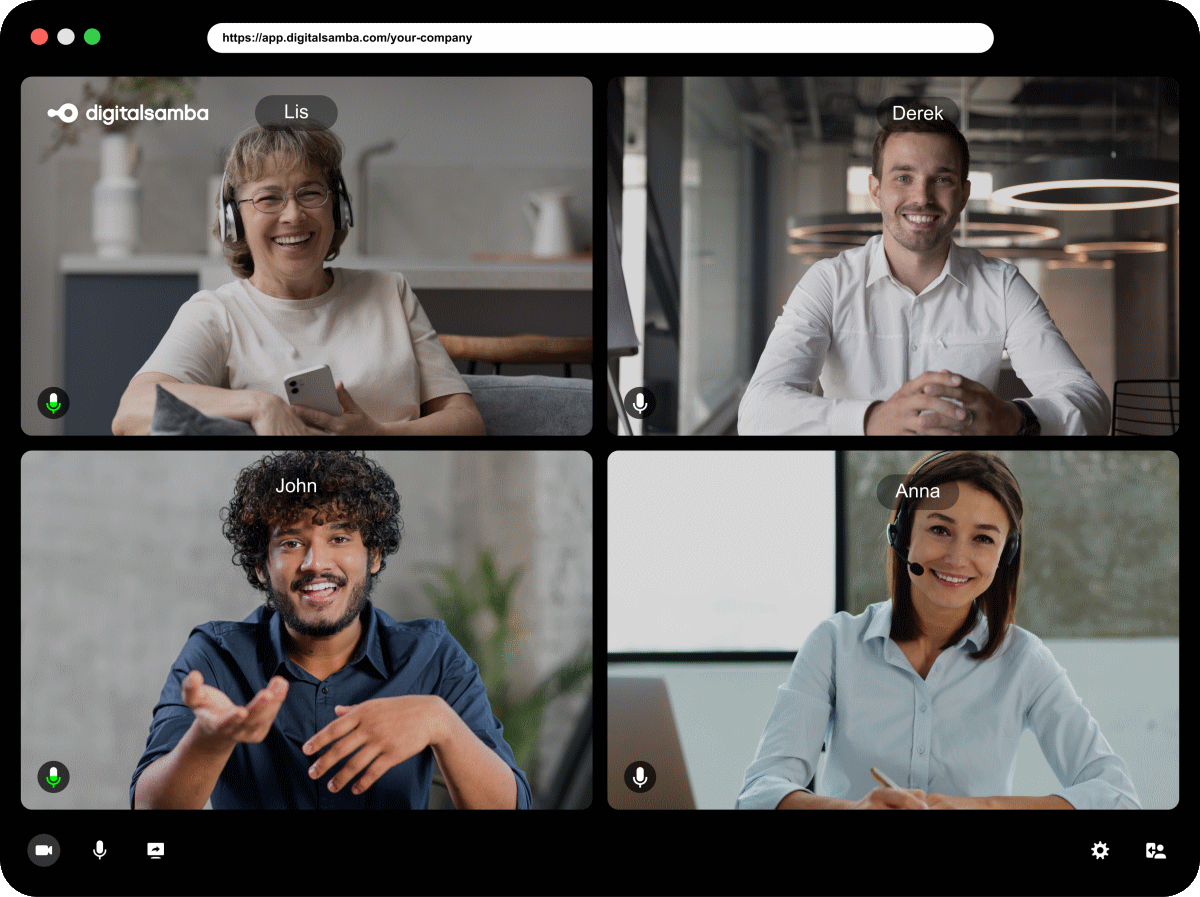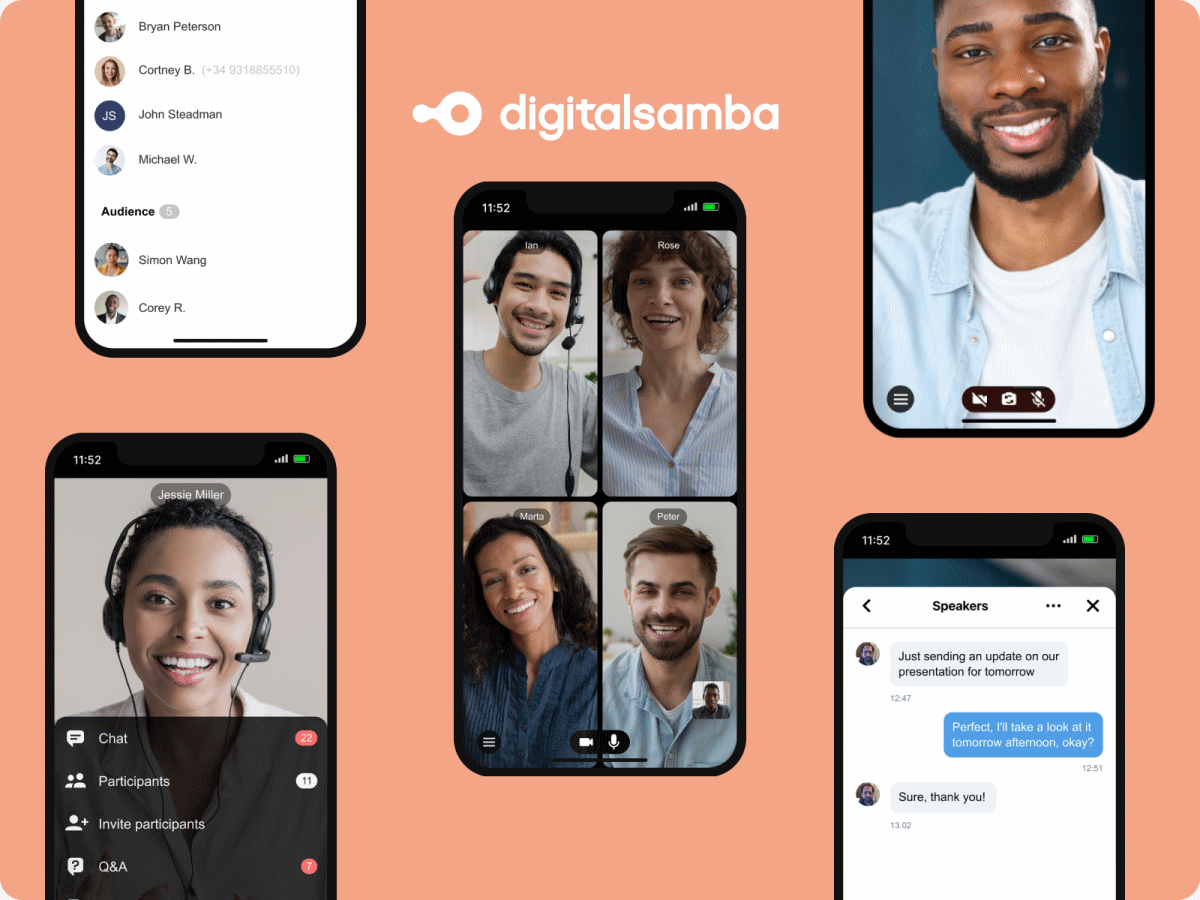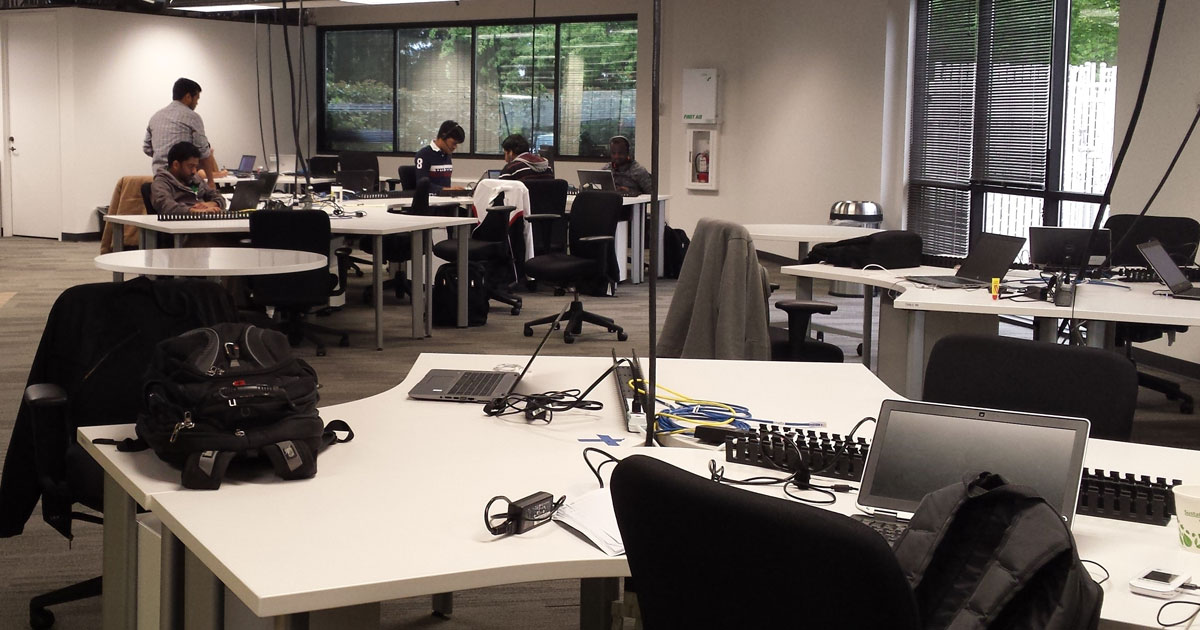Types of Online Meetings: Pros and Cons Explained
In recent decades, our workplaces have been permanently altered by advances in technology. Being at the office five days a week is no longer the norm.
Everything we did in-person - client meetings, performance appraisals, team meetings and workshops can now be done online. The rise of virtual meetings has changed our working habits forever.
Table of contents
- Teleconference (audio only)
- Video conference (audio and video)
- Web conference (audio, video and content sharing)
- Virtual meeting examples
- Digital Samba: embedding video conferencing in your business solutions
- Wrap-up
Even before the pandemic, virtual meetings gradually crept into our workplaces via teleconferencing and videoconferencing. The pandemic accelerated the transition to web conferencing quicker than anyone could have imagined, what with the rise of work-from-home, virtual offices, and virtual mail solutions that swept across the globe.

For most organisations, web conferencing solutions are now the go-to means of hosting virtual meetings. Virtual meeting platforms have become advanced, feature-rich collaboration suites in a few short years.
Video conferencing is incredibly popular. Overhead costs are reduced by removing the need for physical office space and improving employee productivity. Online meetings allow remote international teams to communicate as if they were together in a real office.
There are three main types of virtual meetings: teleconferencing (audio-only), video conferencing (with video), and web conferencing (full collaboration tools like screen sharing, chat, and polling). Each serves different communication needs and business contexts.
Teleconference (audio only)
Teleconferencing pioneered the virtual meeting world. It was one of the first technologies that facilitated remote work. Nowadays it has mostly been replaced by video and web meetings.
Typically, we conducted these meetings over a wired office telephone or mobile phone.

Pros
- Simple - most employees are more than familiar with the telephone and its use. Teleconferencing is as simple as pressing a button when you wish to talk. Because this format is audio only, you never need to worry about your camera or lighting.
- No ongoing costs - teleconferencing systems were often purchased up-front, with no ongoing costs. Because of this, they can be a cheap alternative to expensive video conferencing packages.

Cons
- Audio only - Without a visual element, communication can be tricky. Body language is an essential part of day-to-day communication. You would be surprised how many meetings participants rely on visual signals to guide their actions.
- Equipment - In the past, every office employee was equipped with a wired phone or work mobile. In 2025, remote teams can function without either. The result is that most modern remote teams lack the necessary equipment for audio-only teleconferences.
Truth be told, most organisations now consider them ineffective due to video and web platforms often including audio-only as a feature.
Video conference (audio and video)
The first internet-based video conferencing apps like Skype and Cisco were considered huge technological advances. Integrating a live video element into remote meetings solves many of the audio-only meetings' problems.
Curious how modern solutions stack up? See our full Digital Samba vs Skype comparison to explore the benefits of secure, browser-based video conferencing for today’s teams.
Early online meeting applications involved downloading client software and some kind of set-up process.

Pros
- Seeing is believing - participants seeing each other during online video meetings was a huge innovation. Participants could now see each other instead of just hearing. Seeing our colleagues makes meetings more personal, allows body language, and makes for a more engaging overall experience.
- Affordability - video conferencing saves money. It doesn’t take a genius to realise that hosting a remote meeting is cheaper than flying half of your team to a different country for a board meeting. Reducing travel time also leaves more time in the day for work activities, increasing employee productivity.
Cons
- Software download - most early virtual communication software required a software download. These could be complicated and time-consuming, usually requiring the input of IT colleagues to complete the setup. Many platforms also require individuals to use software-compatible hardware such as webcams and microphones.
- Security matter - early video conferencing solutions were less secure than those available in 2025. It was commonplace for important meetings to be hacked or subject to technical difficulties.
Web conference (audio, video and content sharing)
Video meeting software eventually evolved into fully-fledged web conferencing platforms. These platforms are completely browser-based and most have a huge range of collaboration-boosting features.

Web-based video conferencing platforms like Digital Samba have our own mobile app, as well as interactive features such as content sharing, cloud storage, Q&A and polling, custom branding, live streaming, breakout rooms and other must-haves business virtual meeting tools.
Pros
- Interactive features - when hosting virtual meetings or events, we want participants to stay engaged. Interactive features like polling, hand-raising, Q&A, and shared notes are important tools we can use to keep participants attention.
- Browser-based - This is a huge benefit when hosting large events or meetings with individuals outside your organisation. It means you can invite people simply by sending a one-click invite link. In the past, attendees had to download your platform, configure it, connect and join.
Cons
- Office network issues - office networks often have a backup network. Unfortunately, most home network connections don’t have a backup. Home network trouble is the biggest downside of web conferencing and is yet to be completely resolved. Participants have very little control over their home connection.

Comparison of different types of online meetings
Choosing the right virtual meeting format depends on your team's needs and the level of collaboration required. Below is a comparison of the three most common types of online meetings—teleconferencing, video conferencing, and web conferencing—highlighting their features, ideal use cases, and typical tools used.
| Feature | Teleconference (audio only) | Video conference (audio + video) | Web conference (full collaboration) |
|---|---|---|---|
| Audio | ✔️ | ✔️ | ✔️ |
| Video | ❌ | ✔️ | ✔️ |
| Content sharing | ❌ | ❌ | ✔️ |
| Browser-based Aass | ❌ | Often ❌ | ✔️ |
| Interactive features | ❌ | Limited | ✔️ (polls, Q&A, whiteboards) |
| Best use case | Quick check-ins, low bandwidth | Personal meetings, team updates | Webinars, demos, onboarding |
| Equipment needed | Phone or headset | Webcam + mic | Laptop with browser access |
| Typical platform examples | Landline, mobile, VoIP | Skype, early Zoom, FaceTime | Digital Samba, Google Meet, Teams |
Virtual meeting examples
Here are some of the most common virtual meeting examples businesses use today to stay connected, productive, and collaborative—no matter where their teams are located:
-
Team stand-ups
These are short, daily or weekly video calls where team members quickly align on goals, tasks, and blockers. Often used in Agile workflows, virtual stand-ups keep remote teams in sync and ensure accountability without the need for lengthy meetings. -
Client demos
Hosted via web conferencing platforms, client demos allow businesses to present their products or services in real-time. These meetings often include screen sharing, presentations, and live walkthroughs, offering clients a personalised experience while reducing travel time and costs. -
Webinars
Webinars are structured, often one-to-many sessions designed to educate, inform, or promote. They include interactive features like live Q&A, polls, chat, and even breakout rooms. Businesses use webinars to launch products, train customers, or establish thought leadership on key industry topics. -
One-on-one reviews
These private video meetings between managers and employees are used for performance reviews, goal setting, and coaching. Virtual one-on-ones create a dedicated space for honest, uninterrupted conversation, even in remote or hybrid work setups. -
Remote onboarding
Onboarding new hires remotely involves a series of interactive virtual sessions—ranging from welcome calls to policy walkthroughs and role-specific training. By using video conferencing tools with shared content and screen sharing, companies can provide a consistent, engaging onboarding experience without needing everyone in the same physical location.
Digital Samba: embedding video conferencing in your business solutions
When it comes to leading the way in the seamless integration of video conferencing into software products or websites, Digital Samba stands apart. As a GDPR-compliant, EU-hosted provider with end-to-end encryption, we offer technology that meets stringent privacy and security requirements.
Our WebRTC video API allows businesses to embed video calls on websites with ease, and our web conference API facilitates comprehensive integration into various platforms. This empowers organisations to create customised video conferencing experiences tailored to their unique needs.
With our advanced feature sets, including the ability to host web conferences with full audio, video, and content-sharing capabilities, we're at the forefront of the virtual meeting world. Our solutions are more than just communication tools; they are catalysts that bring remote teams together, creating collaborative environments that transcend geographical boundaries.
Discover how Digital Samba can elevate your business's virtual communication. Contact us today to learn more about our innovative solutions.
Wrap-up
Understanding the different types of online meetings is essential for choosing the right format for your team. Whether it's a quick check-in via audio, a collaborative session with shared content, or a fully integrated browser-based event, each type serves a unique purpose.
Contact our team to discuss which type of virtual meeting you should use for your business meetings.
FAQs
1. What are the main types of virtual meetings?
The three main types are teleconferencing (audio only), video conferencing (audio and video), and web conferencing (audio, video, and content sharing). Each suits different communication needs depending on the level of collaboration required.
2. Which type of online meeting is best for remote teams?
Web conferencing is usually best—it supports real-time video, content sharing, chat, and interactive tools like polls and breakout rooms, which help remote teams collaborate more effectively.
3. Do I need to download software to join a virtual meeting?
Not always. Many modern platforms like Digital Samba are browser-based, so attendees can join with just a link—no downloads required.
4. Can virtual meetings fully replace in-person meetings?
For many businesses, yes. While some in-person interactions are still valuable, virtual meetings now offer tools that support collaboration, relationship-building, and even spontaneous discussions.
5. What are some examples of online meetings used in business?
Examples include team stand-ups, client demos, training sessions, webinars, and one-on-one reviews. Each serves a specific business goal and can be hosted virtually with the right tools.
6. How do I choose the right virtual meeting platform?
Look for features that match your use case—like screen sharing, end-to-end encryption, breakout rooms, or custom branding. Also, consider where data is hosted if privacy or GDPR compliance matters to you.
Share this
You May Also Like
These Related Stories

Your Guide To Cloud Video Conferencing Solutions

Alternatives to Open Office Layouts


